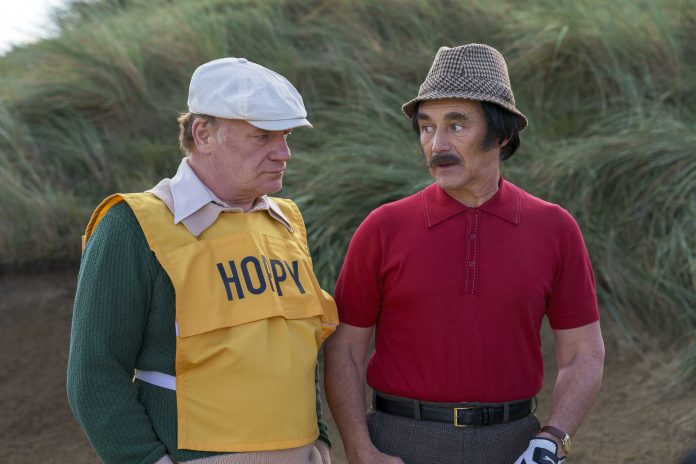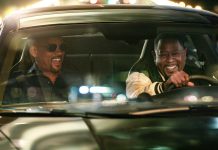
By JOCELYN NOVECK
AP National Writer
As one of our most talented living actors on screen or stage, Mark Rylance certainly knows how to speak beautifully. But sometimes it seems the essence of his acting emerges in those blank seconds between words.
He hems, he haws, he pauses, he hesitates. He’s never afraid of leaving a few beats of dead space, and it keeps us off guard — often making us forget we’re hearing lines from a script.
Rylance is also one of those few actors who can power an entire film, and “The Phantom of the Open” definitely rides on the strength of his signature quirky energy as it tells the true-life story of Maurice Flitcroft, a shipyard crane operator from northern England who stunned the golfing world in 1976 by entering the British Open under false pretenses — he’d never played a round of golf — and shooting the worst qualifying round in Open history. Then he entered a bunch more times, under false names and in disguise, earning folk hero status along the way.
But Flitcroft wasn’t joking. He truly believed he had a chance, and he had undying support from his wife, Jean, who urged him to follow his dreams. As did two of his sons, whom he encouraged to do the same — they were global disco dancing champions (yes, we said disco dancing champions.)
So you have a great real-life story and one of the world’s best actors to tell it, along with the marvelous Sally Hawkins as Jean, who brings shading and poignancy to what could have been a formulaic part (with occasionally gooey dialogue). You also have a fun soundtrack full of period pop references and original music by Isobel Waller-Bridge.
Yet with all that going for them, director Craig Roberts and writer Simon Farnaby don’t ever truly show us why Flitcroft did what he did. What was the drive behind his, er, drives? He was clearly serious, but why golf, something he’d never attempted in his half century on earth? The film is so entertaining, it pretty much gets away without exploring the question.
In an opening sequence recapping Flitcroft’s life up to 1975, we learn that shipyard work was the only option for a young working-class man in Barrow-in-Furness at the northwest tip of England. But when, at age 46, social conditions imperil his career, his wife urges him to find a new dream. Watching telly one day, he happens on a golf tournament. Something clicks in his brain. The moment is captured in a dream sequence where Flitcroft mounts and is catapulted from an actual tee — as if he were a golf ball.
Soon, Jean is helping him fill out entry forms to the Open. Adorably, neither of them know what “handicap” means so they decide to disclose his false teeth and “a touch of arthritis.” When his application arrives, supercilious tournament authorities assume nobody would be stupid enough to say they’re a golf pro if they’re not.
So the ruse begins. It does not go well, but at the end of an amusing day, a TV announcer intones: “The day belongs to Maurice.” For most of the world, it’s a fun joke. Flitcroft himself is insulted by that assumption. He will be back, he promises: “Practice is the road to perfection.”
A journalist latches onto the story and suddenly Maurice is the “Phantom of the Open.” A montage of his media notoriety is accompanied by a hugely entertaining dance sequence to the strains of Abba’s “Money, Money, Money.” But golf authority Keith Mackenzie — a terrifically stuck-up Rhys Ifans — is furious. He bans Flitcroft from joining any golf clubs. Also, older son Mike, who is upwardly mobile at the shipyard, is deeply ashamed.
But Jean remains ever true. “How do you think Jack Nicholson would have done if he’d taken up golf at 50?” she asks supportively. Maurice corrects her gently: “Jack Nicklaus.”
It’s Jean who suggests that perhaps Maurice can get back to the Open by entering as someone else. A dashing Frenchman, perhaps? They try out a fake mustache. “Tres chic,” she says. “Bonjour,” he replies. The Hawkins-Rylance chemistry is a treat.
That chemistry is especially potent at the crowd-pleasing end, during a detour to Michigan, of all places. The closing footage of the real Maurice is utterly fascinating and hints that perhaps his story wasn’t as sweet as the one we’ve just seen. But it’s hard to deny it’s been a darned enjoyable 18 holes.



















